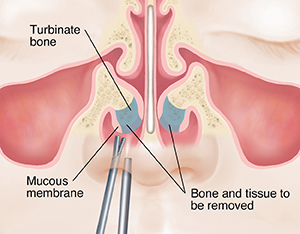Nasal Surgery: Turbinate Surgery
You’re scheduled to have nasal surgery. The type of nasal surgery you’re having is called turbinate surgery. Read on to learn more about what to expect during this surgery.
What are the turbinates?
The turbinates are located on the inside of each side of your nose. They are curved bony ridges that are lined with mucous membrane. Mucous membrane is thin tissue that also lines the insides of your sinuses and throat. It makes sticky mucus that helps clean the air in the nose of dust and other small particles. The turbinates and mucous membrane warm and moisten the air you breathe through your nose.
What to expect during turbinate surgery
This surgery fixes a blockage caused by enlarged turbinates. The surgeon makes cuts (incisions) inside the nose under the lower turbinate. The surgeon may use a laser to do this or may remove extra bone to make the turbinate smaller. Sometimes the surgeon also removes excess mucous membrane.
 |
| During surgery, bone or mucous membrane may be removed from enlarged turbinates. |
Risks of surgery
As with any surgery, nasal surgery has some risks. These include a slight risk of bleeding and infection. Your healthcare provider will discuss any other risks and complications with you.
After turbinate surgery
After turbinate surgery, you’ll be taken to the PACU (postanesthesia care unit) to be closely watched as you wake up from surgery. Your experience may be as follows:
-
You may have packing or a plastic splint inside your nose if you had a septoplasty or sinus surgery along with the turbinate surgery.
-
You may also have bandages (dressings) on the outside of your nose.
-
It’s normal to have some mucus and blood drain from your nose. Until packing is removed, you may have to breathe through your mouth.
-
Expect some throat dryness and irritation. This is normal after general anesthesia or having a tube down your throat.
-
Pain medicine will be prescribed as needed. Don’t take medicine containing aspirin or ibuprofen. These can increase bleeding.
Follow up
You’ll need to follow up with your healthcare provider within a week after your surgery. Here is what to expect:
-
Any packing, splint, or dressings will probably be removed. You may feel slight discomfort and bleed a little when this is done.
-
After the splint or packing is removed, you’ll most likely breathe better than you did before surgery.
-
You may have minor numbness, pain, swelling, and a little stiffness under the tip of the nose.
-
In a few days, the inside of your nose may swell and briefly block your breathing. Or a scab or crust may block breathing for a short time. Leave the scab alone. Your healthcare provider can remove it. Using a saline solution in your nose as directed may help reduce and remove crusts.
-
Contact your healthcare provider if you have any questions, concerns, or unusual symptoms when you get home.
Online Medical Reviewer:
Ashutosh Kacker MD
Online Medical Reviewer:
Rita Sather RN
Online Medical Reviewer:
Tara Novick BSN MSN
Date Last Reviewed:
7/1/2022
© 2000-2024 The StayWell Company, LLC. All rights reserved. This information is not intended as a substitute for professional medical care. Always follow your healthcare professional's instructions.